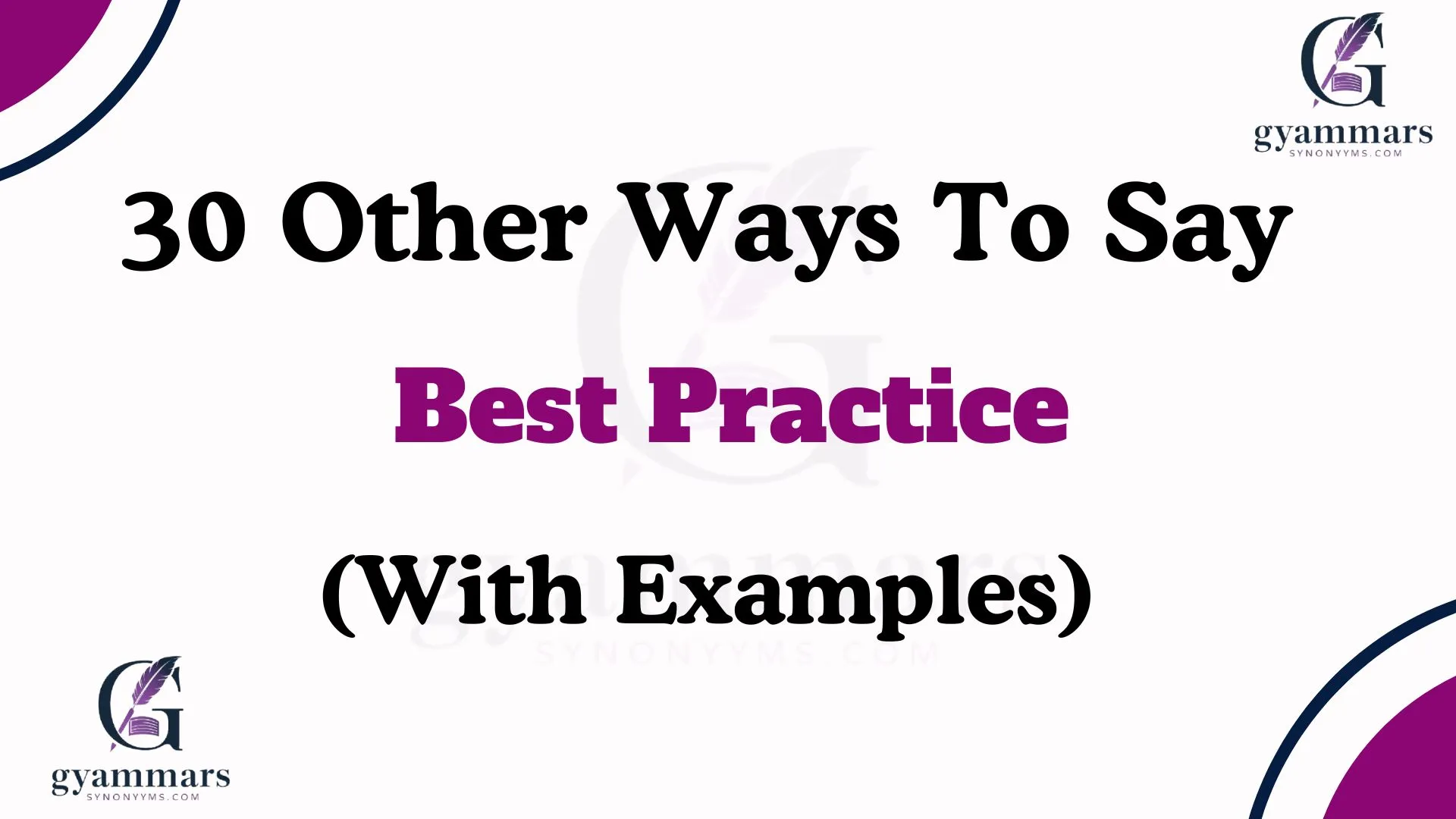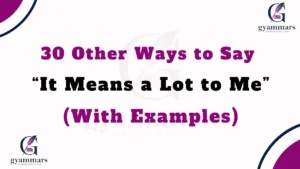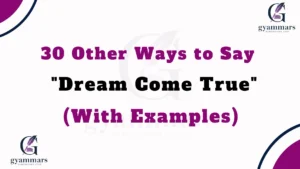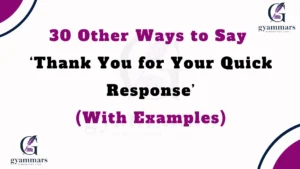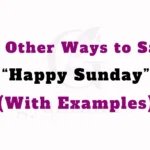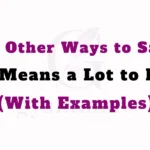The phrase “best practice” is commonly used in professional, business, and academic settings to describe the most effective method or approach for achieving a desired outcome. However, using alternative phrases can help diversify your language and make communication more engaging and precise.
Below is a list of 30 different ways to say “best practice”, along with examples to illustrate how they can be used in context. Whether you’re writing reports, emails, or presentations, these alternatives will help you convey your message more effectively.
What Does “Best Practice” Mean?
‘Best practice’ refers to a method or technique that has consistently shown superior results compared to other means. It’s a standard way of doing things that multiple organizations can adopt to achieve optimal outcomes.
Is It Professional/Polite to Say ‘Best Practice’?
Using ‘best practice’ is both professional and polite. It conveys adherence to proven methods and standards. However, in contexts where a more personalized or nuanced expression is desired, considering alternatives can enhance the message’s warmth and relatability.
Pros and Cons of Using ‘Best Practice’
Pros:
- Widely understood across various industries.
- Conveys a commitment to quality and excellence.
Cons:
- May come across as generic or impersonal.
- Overuse can lead to it becoming a cliché.
Synonyms For ‘Best Practice’
- Standard Procedure
- Benchmark
- Guideline
- Gold Standard
- Standard Operating Procedure (SOP)
- Exemplary Method
- Model Approach
- Proven Technique
- Established Protocol
- Effective Strategy
- Recommended Approach
- Optimal Solution
- Ideal Practice
- Proven Method
- Leading Practice
- Preferred Approach
- Tried-and-Tested Technique
- Industry Standard
- Reliable Framework
- Time-Tested Practice
- Proven Framework
- Efficient Approach
- Model Standard
- Tried-and-True Solution
- Best Course of Action
- Recognized Practice
- Reliable Procedure
- Practical Application
- Tested Approach
- Strategic Plan
1. Standard Procedure
Definition: A set method regularly followed to achieve consistent results.
Explanation: Emphasizes routine and consistency in processes.
Scenario Example: “Following the standard procedure ensures all safety protocols are met.”
Best Use: When highlighting established methods in operational contexts.
Tone: Neutral, formal.
Additional Notes: Ideal for technical or administrative settings.
2. Benchmark
Definition: A standard or point of reference against which things may be compared.
Explanation: Used to measure the quality or performance of a process or product.
Scenario Example: “Our new software sets a benchmark for user-friendly design.”
Best Use: When setting standards or goals.
Tone: Professional, aspirational.
Additional Notes: Often used in performance evaluations.
3. Guideline
Definition: A general rule, principle, or piece of advice.
Explanation: Provides direction on how to approach a task or situation.
Scenario Example: “Please refer to the company guidelines when drafting reports.”
Best Use: When offering advice or instructions.
Tone: Advisory, supportive.
Additional Notes: Suggests flexibility and adaptability.
4. Gold Standard
Definition: The best, most reliable, or most prestigious thing of its type.
Explanation: Represents the highest quality or benchmark.
Scenario Example: “Their customer service is the gold standard in the industry.”
Best Use: When highlighting exemplary quality.
Tone: Complimentary, high praise.
Additional Notes: Often used to denote excellence.
5. Standard Operating Procedure (SOP)
Definition: A set of step-by-step instructions compiled by an organization to help workers carry out routine operations.
Explanation: Ensures consistency and compliance in daily tasks.
Scenario Example: “According to the SOP, all equipment must be inspected weekly.”
Best Use: In operational and compliance contexts.
Tone: Technical, formal.
Additional Notes: Common in industries requiring strict protocols.
6. Exemplary Method
Definition: A model approach that serves as an example worth imitating.
Explanation: Highlights methods that are commendable and worthy of replication.
Scenario Example: “Her exemplary method in project management led to the team’s success.”
Best Use: When recognizing outstanding approaches.
Tone: Appreciative, laudatory.
Additional Notes: Ideal for commendations and acknowledgments.
7. Model Approach
Definition: An ideal method that can be emulated by others.
Explanation: Serves as a template for others to follow.
Scenario Example: “The company’s model approach to sustainability has inspired many.”
Best Use: When suggesting methods for replication.
Tone: Encouraging, positive.
Additional Notes: Useful in training and development contexts.
8. Proven Technique
Definition: A method that has been tested and consistently yields positive results.
Explanation: Emphasizes reliability and effectiveness.
Scenario Example: “Using proven techniques can enhance productivity.”
Best Use: When recommending reliable methods.
Tone: Assured, confident.
Additional Notes: Conveys trust in the method’s efficacy.
9. Established Protocol
Definition: A formally accepted procedure or system followed in specific situations.
Explanation: Refers to structured and recognized methods ensuring consistency and accuracy.
Scenario Example: “The established protocol for handling customer complaints has improved satisfaction rates.”
Best Use: When referring to structured guidelines in professional or technical settings.
Tone: Formal, authoritative.
Additional Notes: Common in medical, legal, and corporate environments.
10. Effective Strategy
Definition: A well-planned approach designed to achieve a specific outcome.
Explanation: Focuses on methods that have been tested and proven to work efficiently.
Scenario Example: “Implementing an effective strategy for time management can boost productivity.”
Best Use: When discussing goal-oriented planning.
Tone: Motivational, goal-driven.
Additional Notes: Common in business, marketing, and coaching.
11. Recommended Approach
Definition: A suggested method considered optimal for achieving a goal.
Explanation: Emphasizes expert or industry-backed advice.
Scenario Example: “The recommended approach for conflict resolution involves active listening and empathy.”
Best Use: When offering expert-backed advice.
Tone: Supportive, advisory.
Additional Notes: Useful in guidance-based conversations.
12. Optimal Solution
Definition: The best possible way to resolve a problem or achieve a goal.
Explanation: Highlights the most efficient and beneficial method available.
Scenario Example: “Outsourcing became the optimal solution to reduce overhead costs.”
Best Use: When discussing the most effective choice in decision-making.
Tone: Logical, results-oriented.
Additional Notes: Often used in decision-making contexts.
13. Ideal Practice
Definition: A method considered to be the most suitable in a given context.
Explanation: Refers to an approach that meets the highest standards.
Scenario Example: “The ideal practice for maintaining mental well-being includes mindfulness and exercise.”
Best Use: When discussing the best habits in various contexts.
Tone: Encouraging, insightful.
Additional Notes: Common in health, education, and coaching.
14. Proven Method
Definition: A tested and successful way of achieving results.
Explanation: Relies on past success and empirical data.
Scenario Example: “Using a proven method for software development minimizes bugs.”
Best Use: When emphasizing reliability.
Tone: Trustworthy, evidence-based.
Additional Notes: Best for professional and research-driven discussions.
15. Leading Practice
Definition: An approach recognized as the best within a specific industry.
Explanation: Used to highlight industry-standard or top-tier methods.
Scenario Example: “Their customer service training follows leading practices in hospitality.”
Best Use: When discussing top industry standards.
Tone: Professional, reputable.
Additional Notes: Common in corporate benchmarking.
16. Preferred Approach
Definition: The method most commonly chosen due to its effectiveness.
Explanation: Indicates a popular choice based on experience or success.
Scenario Example: “The preferred approach to onboarding new hires includes mentorship programs.”
Best Use: When discussing commonly accepted methods.
Tone: Neutral, informative.
Additional Notes: Useful in policy recommendations.
17. Tried-and-Tested Technique
Definition: A method that has been repeatedly used with success.
Explanation: Emphasizes reliability through repeated application.
Scenario Example: “This tried-and-tested technique guarantees higher engagement in online courses.”
Best Use: When recommending a reliable method.
Tone: Assuring, confident.
Additional Notes: Great for instructional content.
18. Industry Standard
Definition: A practice widely accepted and followed within an industry.
Explanation: Represents established norms that ensure consistency and quality.
Scenario Example: “This safety measure is an industry standard in aviation.”
Best Use: When discussing widely accepted professional methods.
Tone: Formal, structured.
Additional Notes: Ideal for corporate and regulatory discussions.
19. Reliable Framework
Definition: A dependable structure used for achieving specific objectives.
Explanation: Provides a structured guide that ensures efficiency.
Scenario Example: “A reliable framework for project management ensures timely delivery.”
Best Use: When presenting structured approaches.
Tone: Systematic, strategic.
Additional Notes: Common in business and education.
20. Time-Tested Practice
Definition: A method that has remained effective over a long period.
Explanation: Proves its value through sustained success.
Scenario Example: “Customer-first policies are a time-tested practice in retail.”
Best Use: When emphasizing longevity.
Tone: Trustworthy, established.
Additional Notes: Best for discussing traditional approaches.
21. Proven Framework
Definition: A structured system that has demonstrated effectiveness over time.
Explanation: Emphasizes a reliable and well-documented approach that consistently delivers results.
Scenario Example: “Using a proven framework in software development speeds up the process without sacrificing quality.”
Best Use: When discussing structured methodologies in professional settings.
Tone: Trustworthy, systematic.
Additional Notes: Frequently used in technology, business, and research discussions.
22. Efficient Approach
Definition: A method that maximizes productivity while minimizing waste or effort.
Explanation: Highlights an optimized process that ensures better outcomes with fewer resources.
Scenario Example: “Switching to digital invoices is a more efficient approach to reducing paper waste.”
Best Use: When discussing time- and resource-saving methods.
Tone: Logical, productivity-focused.
Additional Notes: Best suited for corporate, financial, and workflow improvement discussions.
23. Model Standard
Definition: A practice or guideline that serves as an ideal example to follow.
Explanation: Indicates a high benchmark that others aim to achieve.
Scenario Example: “This company’s sustainability efforts set a model standard for the industry.”
Best Use: When recognizing top-tier practices.
Tone: Formal, aspirational.
Additional Notes: Often used in leadership, corporate excellence, and education.
24. Tried-and-True Solution
Definition: A method proven to work over time through repeated success.
Explanation: Emphasizes dependability and historical effectiveness.
Scenario Example: “Networking remains a tried-and-true solution for career growth.”
Best Use: When recommending well-established methods.
Tone: Reassuring, reliable.
Additional Notes: Frequently used in business, career coaching, and personal development.
25. Best Course of Action
Definition: The most effective decision to take in a given situation.
Explanation: Focuses on making the right choice based on current circumstances and available information.
Scenario Example: “Given the budget constraints, outsourcing is the best course of action.”
Best Use: When discussing decision-making.
Tone: Analytical, decisive.
Additional Notes: Common in strategic planning, risk assessment, and advisory discussions.
26. Recognized Practice
Definition: A method widely accepted as effective within a field or industry.
Explanation: Indicates validation by experts or professionals.
Scenario Example: “Following a recognized practice in project management ensures consistency.”
Best Use: When referring to industry-accepted techniques.
Tone: Professional, credible.
Additional Notes: Best for compliance, regulations, and industry norms.
27. Reliable Procedure
Definition: A dependable method that consistently yields positive results.
Explanation: Focuses on accuracy and repeatability.
Scenario Example: “Double-checking all reports is a reliable procedure for minimizing errors.”
Best Use: When discussing quality control and process integrity.
Tone: Detail-oriented, professional.
Additional Notes: Common in medical, engineering, and financial fields.
28. Practical Application
Definition: A method that can be effectively used in real-world situations.
Explanation: Focuses on applying knowledge or theory in everyday practice.
Scenario Example: “The practical application of design principles can make any website more user-friendly.”
Best Use: When discussing real-world implementation.
Tone: Hands-on, instructional.
Additional Notes: Often used in education, training, and professional development.
29. Tested Approach
Definition: A method that has been evaluated and proven to work.
Explanation: Highlights the reliability of a specific strategy or process.
Scenario Example: “A tested approach to conflict resolution includes active listening and clear communication.”
Best Use: When emphasizing effectiveness through prior use.
Tone: Confident, reassuring.
Additional Notes: Common in leadership, personal development, and teamwork discussions.
30. Strategic Plan
Definition: A carefully designed method to achieve a long-term goal.
Explanation: Emphasizes thoughtful preparation and goal-oriented thinking.
Scenario Example: “Their strategic plan for expansion includes entering new markets next year.”
Best Use: When discussing long-term business or career goals.
Tone: Professional, forward-thinking.
Additional Notes: Frequently used in corporate, marketing, and financial sectors.
Conclusion
Choosing the right words matters, especially when discussing methods, strategies, or approaches. Instead of simply saying “best practice,” you now have a wide range of alternative phrases that add warmth, clarity, and professionalism to your communication. Whether you need a formal, friendly, or results-driven tone, these 30 alternatives will help you express your ideas with precision and confidence.
FAQs
1. Why should I use alternatives to “best practice”?
Using alternatives helps you sound more natural, professional, and engaging depending on the context. Some terms may also better suit specific industries or audiences.
2. Are these alternatives suitable for both professional and casual settings?
Yes! Some phrases, like “gold standard” or “proven technique,” work well in formal settings, while others, like “tried-and-true solution,” can be used in casual conversations.
3. What is the best alternative for corporate or business settings?
For corporate settings, “strategic plan,” “benchmark,” or “industry standard” are strong choices as they convey professionalism and credibility.
4. Can I use multiple alternatives in one conversation or document?
Absolutely! Mixing different phrases helps avoid repetition and keeps communication clear and engaging.
5. Which alternative is best for scientific or technical writing?
Phrases like “proven framework,” “established protocol,” and “tested approach” fit well in research and technical fields.

“Emma Rose at Grammar Synonyms is your go-to expert for everything related to language and expression. Whether you’re refining your grammar, searching for the perfect synonym, or looking for creative ways to improve your writing, Emma Rose provides the tools and inspiration you need. With a wide range of resources designed to elevate your communication, Grammar Synonyms helps you find just the right words to make every sentence shine.
